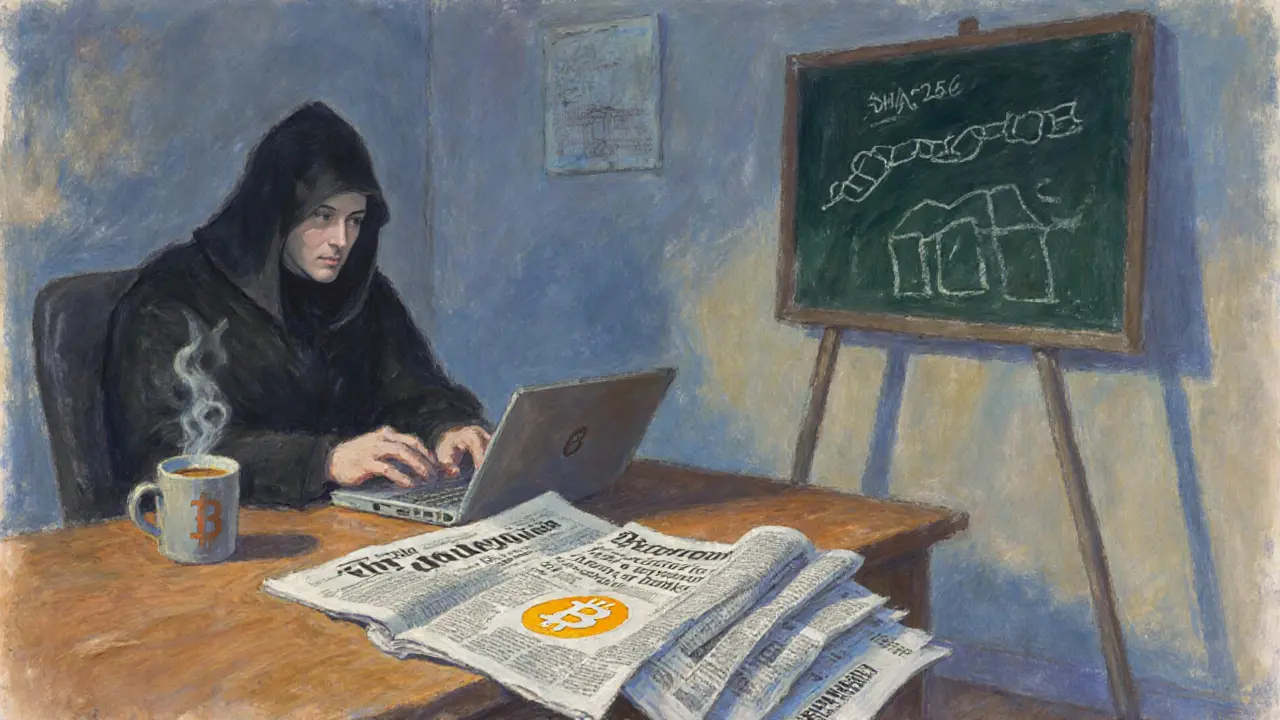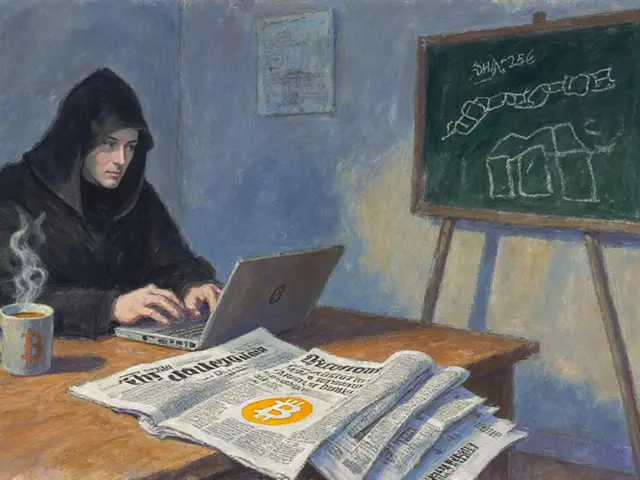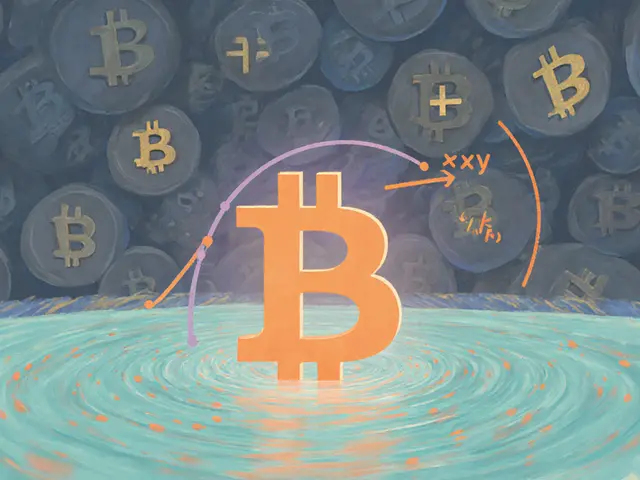Bitcoin Origin: How the First Cryptocurrency Was Created

Bitcoin Origin Timeline
Genesis Block
January 3, 2009
The first block of the Bitcoin blockchain was mined by Satoshi Nakamoto.
Includes a reference to the 2008 financial crisis.
Whitepaper Release
October 31, 2008
Satoshi Nakamoto published "Bitcoin: A Peer-to-Peer Electronic Cash System"
outlining the technical solution to digital cash problems.
First Real Transaction
May 22, 2010
Laszlo Hanyecz bought two pizzas for 10,000 BTC.
Known as "Bitcoin Pizza Day".
First Exchange
July 2010
Mt. Gox launched as the first Bitcoin exchange,
becoming the primary marketplace for Bitcoin.
First Price
March 17, 2010
First recorded Bitcoin price was $0.003 per BTC.
Double-Spending Solution
2008-2009
Implemented SHA-256 proof-of-work to solve the double-spending problem.
Created a decentralized consensus mechanism.
Timeline of Bitcoin's Creation
Did You Know?
The message in the genesis block references the financial crisis of 2008 that motivated Bitcoin's creation. It reads: "The Times 03/Jan/2009 Chancellor on brink of second bailout for banks."
This was a direct reference to the front page of The Times newspaper on January 3, 2009, which was also the day Bitcoin's genesis block was mined.
Ever wondered why Bitcoin exists and what sparked the birth of the whole crypto world? This article walks you through the exact moment Bitcoin emerged, the people and tech behind it, and why that humble start still matters today.
Key Takeaways
- Bitcoin was launched on Jan32009 when the genesis block was mined.
- Satoshi Nakamoto released the whitepaper on Oct312008, proposing a peer‑to‑peer cash system.
- The genesis block includes a hidden message about the 2008 banking bailouts.
- Early milestones: first price ($0.003), first real‑world purchase (2 pizzas), and the rise of Mt.Gox.
- Bitcoin solved the double‑spending problem with SHA‑256 proof‑of‑work, a design that inspired every later cryptocurrency.
What Is Bitcoin?
Bitcoin is a decentralized digital currency that lets anyone send value over the internet without a bank or government acting as middle‑man. Its network records every transaction on a public ledger called a blockchain, and new coins are created through a process known as mining.
Why the 2008 Financial Crisis Mattered
In late 2008 the world watched banks receive massive bailouts. The front page of The Times on Jan32009 read, “Chancellor on brink of second bailout for banks.” Satoshi embedded that exact headline in the first block of Bitcoin’s chain, turning the headline into a permanent reminder of why a trust‑less system was needed.
Satoshi Nakamoto and the Whitepaper
Satoshi Nakamoto (a pseudonym) posted the seminal document “Bitcoin: A Peer‑to‑Peer Electronic Cash System” to a cryptography mailing list on Oct312008. The paper outlined how cryptographic proof‑of‑work could solve double‑spending without a central authority.
Mining the Genesis Block
The very first block-often called the genesis block-was mined on Jan32009. It used the SHA‑256 hash algorithm, a cryptographic function that turns any input into a 256‑bit “fingerprint.” Miners compete to find a SHA‑256 hash lower than a target value; the winner adds a new block and receives newly minted bitcoins as a reward.

Early Milestones: Price, Pizza, and Mt.Gox
The first recorded price appeared on March172010, when a user paid $0.003 per BTC. A month later, on May222010, programmer LaszloHanyecz bought two PapaJohn’s pizzas for 10,000BTC-now celebrated as “Bitcoin Pizza Day.” The first exchange, Mt.Gox, launched in July2010 and quickly became the primary market for buying and selling Bitcoin.
Precursors That Set the Stage
| Project | Year | Key Innovation | Why It Fell Short |
|---|---|---|---|
| eCash (David Chaum) | 1995 | Blind signatures for privacy | Required trusted banks and software |
| b‑money (WeiDai) | 1998 | Distributed ledger concept | No concrete implementation |
| Bit Gold (Nick Szabo) | 1998 | Proof‑of‑work with linked hashes | Lacked a network and incentive model |
| Bitcoin | 2009 | Fully functional P2P network, immutable blockchain, built‑in scarcity | None - became the first widely adopted cryptocurrency |
How Bitcoin Solved Double‑Spending
Before Bitcoin, digital cash systems could’t prevent a user from copying a digital token and spending it twice. Bitcoin’s solution combines three elements:
- Every transaction is broadcast to the whole network.
- Miners bundle transactions into a block and compute a SHA‑256 hash that meets a difficulty target (proof‑of‑work).
- The winning block is added to the chain; once a block is buried under subsequent blocks, altering it would require re‑doing the proof‑of‑work for all later blocks-practically impossible.
This mechanism creates a single source of truth without any trusted third party.
Legacy and Impact as of 2025
Sixteen years after its birth, Bitcoin continues to shape finance. Its market cap regularly tops $1trillion, and major institutions like CME Group offer Bitcoin futures to hedge risk. The protocol’s built‑in halving events-occurring roughly every four years-reduce new supply, reinforcing scarcity. Bitcoin’s success sparked a wave of over 25,000 alternative cryptocurrencies, each tweaking the original design in search of new use cases.
Quick Checklist: What You Should Remember
- Genesis block date: Jan32009.
- Creator’s pseudonym: Satoshi Nakamoto.
- Key tech: SHA‑256 proof‑of‑work, immutable blockchain.
- First real‑world use: 10,000BTC for two pizzas (May222010).
- Early exchange that popularized trade: Mt.Gox.
FAQ
When was the first cryptocurrency created?
Bitcoin, launched on Jan32009, is universally recognized as the world's first fully functional cryptocurrency.
Who is Satoshi Nakamoto?
Satoshi Nakamoto is the pseudonymous creator of Bitcoin. Their true identity remains unknown, and they vanished from public view in 2010.
What is the significance of the message in the genesis block?
The genesis block includes the headline “Chancellor on brink of second bailout for banks,” highlighting the 2008 financial crisis that motivated Bitcoin’s creation.
How did Bitcoin’s first real‑world transaction happen?
On May222010, programmer Laszlo Hanyecz paid 10,000BTC for two pizzas, marking the first documented purchase using Bitcoin.
Why does Bitcoin matter today?
Bitcoin introduced a decentralized, censorship‑resistant monetary system that inspired an entire ecosystem of digital assets, DeFi platforms, and blockchain innovations still reshaping finance.
Understanding the Bitcoin origin gives you a solid foundation for navigating today’s crypto landscape, whether you’re trading, building on the blockchain, or simply curious about how a crisis led to a monetary revolution.







Bitcoin isn’t the revolution they hype.
From a systemic perspective, the inception of Bitcoin constitutes a paradigm shift in decentralized ledger technology, whereby cryptographic proof‑of‑work mechanisms supplant traditional fiduciary intermediaries.
Exactly, the proof‑of‑work consensus introduced by Satoshi essentially solved the double‑spending problem, allowing peer‑to‑peer transactions without a trusted third party. It also laid the groundwork for countless subsequent blockchain projects.
While the historical narrative extols Bitcoin’s innovation, one must acknowledge the intellectual lineage tracing back to eCash and Bit‑Gold, which, albeit incomplete, provided critical conceptual scaffolding for the eventual implementation.
Indeed, David Chaum’s eCash introduced blind signatures for privacy, and Nick Szabo’s Bit‑Gold pioneered proof‑of‑work with linked hashes. However, those systems lacked a native incentive model and a robust peer‑to‑peer network, which Bitcoin integrated seamlessly. This synthesis is why Bitcoin achieved real‑world adoption while its predecessors remained academic curiosities.
Sure, but let’s not pretend Bitcoin isn’t just a speculative bubble 🤷♂️.
Wow, it’s crazy how a simple idea about “digital cash” turned into a whole new financial universe – truly mind‑blowing!
Honestly, the hype feels like a circus, and the drama surrounding price spikes is just another layer of emotional manipulation.
The genesis block’s embedded headline, “Chancellor on brink of second bailout for banks,” serves as a sociopolitical anchor, embedding contextual relevance directly into the protocol’s immutable layer.
That’s a great observation; it underscores how technical design can carry a powerful ideological message, rallying early adopters around a shared vision of financial sovereignty.
History often repeats itself, and Bitcoin’s emergence reminds us that crises can incubate groundbreaking solutions that challenge the status quo.
Or maybe the whole “crisis‑driven innovation” story is just a convenient myth fabricated to legitimize a covert agenda.
Loved the timeline – super clear and concise! 😊
Thanks! Glad you found it helpful – the early milestones really set the stage for everything that followed.
It’s fascinating to see how a single whitepaper sparked an entire ecosystem of decentralized applications, NFTs, DeFi, and beyond.
Absolutely, and what’s remarkable is the collaborative spirit that emerged across borders, turning a niche cryptographic concept into a global movement.
Everyone praises Bitcoin’s decentralization, yet the mining concentration in a few regions raises serious questions about true distribution.
Your point is valid; the geographic concentration of mining pools does challenge the ideal of decentralization, prompting ongoing discussions about proof‑of‑stake alternatives.
Does anyone ever wonder how Bitcoin’s energy consumption compares to the traditional banking sector’s carbon footprint?
Of course, because the real secret is that the entire “energy debate” is just a smokescreen engineered by the elite to distract us.
In the end, Bitcoin teaches us that technology can reshape our notions of value and trust.
Exactly! Let’s keep pushing the boundaries and show the world what decentralized finance can really achieve.
yeah, same old story, more hype and less real change 😂